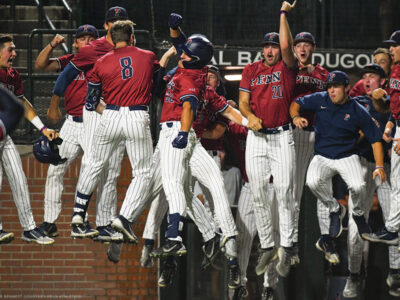Undergraduate Research | It seems so obvious sometimes: late in a close game, runners in scoring position, a square-jawed veteran digging in at the plate. He smacks a double into the gap—or at least knocks in a run with a sacrifice fly. He’s a “clutch hitter,” and will be acclaimed as such by high-testosterone announcers in broadcasting booths across the land.
But is he really? Baseball stat-heads argue that there’s no such animal as a clutch hitter—that while a player might perform better than most in some clutch situations, even for a year or two, it all evens out over the thousands of Major League at-bats that make up a career.
Into that debate steps College senior Elan Fuld, a baseball fan and a mathematics and economics major from Brookline, Massachusetts. Though he is clearly more of a sabermetrician (fancy baseball word for stat-head) by temperament, Fuld wasn’t convinced by the arguments of either side, including the stat-head research he had seen. And so last summer, as part of the University Scholars program—which provides mentoring, research funding, and scholarly events for “intellectually dynamic students who have already demonstrated their commitment and dedication to research”—he began studying the batting statistics of 1,075 Major League players in the 1974-1992 seasons. After presenting his results, full of Gompertz regressions and scatter-plots, at a University Scholars luncheon this past semester, he recently released a draft of a paper titled “Clutch and Choke Hitters in Major league Baseball: Romantic Myth or Empirical Fact.”
He concluded that there is, in fact, some empirical fact behind the myth. But career clutch hitters are very few and far between—between 1 and 4 percent of all Major Leaguers—and they’re not always the players the average fan would expect.
True, his top clutch hitter was Eddie Murray, the slugging first baseman for the Baltimore Orioles, who “showed up significantly clutch” under nine of the 12 sets of assumptions Fuld devised. But another of his top five was Bill Buckner, whose fielding error for the Boston Red Sox in Game 6 of the 1986 World Series saddled him with a “choke” label that still lingers. (Fuld wisely did not venture into the statistical minefield that is fielding.) Other clutch hitters included Darryl Hamilton, Frank Duffy, and Luis Gomez.
Though a few names made the “choke” list, he didn’t consider those results statistically reliable. “There wasn’t any real evidence that there were choke hitters,” says Fuld, “which in a way makes sense because you’d think that the people who crumble under pressure don’t make it through the Majors. There are lots of people who crumble under pressure, but they don’t become Major League hitters. At least I don’t have any evidence that they do.”
Fuld’s definition of clutch and choke hitting is “one who performs better/worse at more important points of the game,” and he measured both the importance of the game situation and the performance of the player, assigning values to each. He did not try to rank the importance of individual games. (“Any definition that includes performing better in ‘bigger’ games as part or all of its definition would create a serious flaw with any study that attempted to use it,” he writes: “You can’t numerically measure how much more important one game is over another.”)
To determine the situational importance of a player’s at-bat, he looked at such elements as a team’s lead, which bases were occupied, how many outs there were, and which half-inning it was. He used six sets of assumptions that involved sacrifice flies and errors in different ways, a process that allowed for only a 1 percent chance of a player showing up as clutch or choke if he was not.
“The sacrifice flies mattered a lot,” says Fuld. “When I didn’t include them, I didn’t really have evidence for clutch hitting. Not that it didn’t exist; just that there wasn’t enough to show it did. When I included them, there was overwhelming evidence for clutch hitting existing.”
While that evidence may provide confirmation of the beliefs of some sportswriters and announcers, it doesn’t mean that their tendency to anoint players as “clutch” has any bearing on reality.
“You hear it all the time on the news, on sports broadcasts,” he says. “Clearly the sports broadcasters think that every third player is ‘clutch’ or something. But the results I got didn’t show anything like that.”—S.H.




